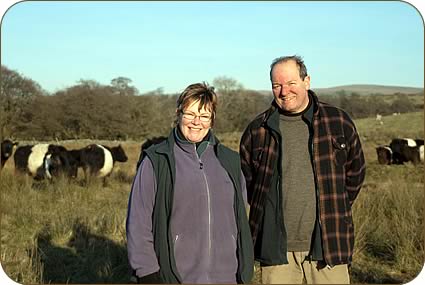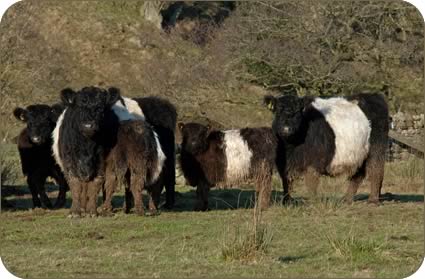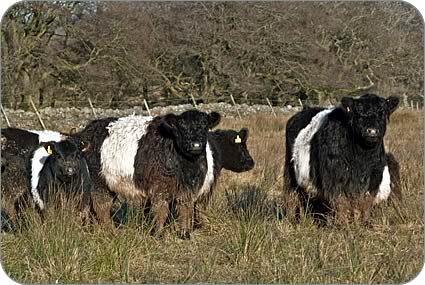Jennifer MacKenzie is an agricultural photo journalist with almost 30 year's experience. Operating from her base in Cumbria, Jennifer undertakes mainly industry-related freelance writing and photography.
Askerton Castle Belted Galloways
When Jane Eden and her partner Chris Evans began farming almost by default
they quickly decided that traditional breeds would be perfectly suited
to turning the rough hill pasture of the Askerton Castle Estate into quality
meat.
Now, almost 10 years since they began farming the 1,458 acre estate near Brampton in north Cumbria, they are running one of the largest pedigree herds of Belted Galloways, along with Scottish Blackface and Kerry Hill sheep, Tamworth and Gloucester Old Spot pigs as well as hens, retailing virtually all they produce.
 |
| Jane Eden and Chris Evans with Belted Galloway cows and calves |
The couple moved from London 14 years ago where both had previously worked in business - Jane in publishing, although latterly as a full-time mother, and Chris as managing director of the UK subsidiary of a German credit card company - to live in the listed fortified medieval manor house three miles north of the Roman Wall, Jane having inherited the family estate.
However, after 2001’s foot and mouth epidemic the tenant farmer decided to retire, giving Jane and Chris the opportunity to farm the estate in hand - a decision they made quite quickly.
“Having had sales and marketing experience, we couldn’t understand how the farming industry worked, spending two or two and a half years rearing an animal without having any idea of the price the animal would make and what return there would be on what was invested in it,” said Chris. For both the whole experience has been a huge learning curve which they have been able to look at afresh coming from outside the industry.
They opted for Belted Galloways because of the slow maturing, quality meat they produce. On the Rare Breeds Survival Trust endangered species list a decade ago, they tended to be kept in smaller herds and the temperament generally was good - of particular importance when starting in farming in mid-life.
It was also felt that the breed would suit the estate’s land, which is mainly Severely Disadvantaged land with rough grazing, and an organic system. The estate is coming to the end of its ten years in Countryside Stewardship with its wildflower meadows and SSSI which includes an ancient burial site or particular interest to conservationists.
“Belted Galloways can’t be pushed on to finish and as far as most people would say the meat is superior but you have to pay a premium for it,” said Jane. “If you liken it to tomatoes or rhubarb which are forced, they don’t have the depth of taste if the plants were grown slowly,” she added.
“We felt that the traditional breeds were the way forward. We’re relatively new to the industry and we have found our own little niche. It has got to be something I get real pleasure from - and I’m passionate about Belties,” said Jane.
 |
| Belted Galloway cows and calves |
The tenant farmer gave the couple a year’s notice in May 2001 and by September Jane had enrolled on a full-time national diploma in hill farming course at Newton Rigg College, Penrith.
The Askerton Belted Galloway herd was started with the purchase of a herd of 24 pedigree and unregistered females from Ian Barnes on Anglesey who was retiring.
The herd’s first stock bull was from the world renowned Belted Galloway expert late Miss Flora Stewart’s Mochrum herd in Wigtownshire who gave the couple help and advice. They also bought Janes’s favourite female from her.
Since then the herd has grown to an optimum number of 70 plus cows and followers. It has been closed for some years with the majority of the stock being home-bred and some new bloodlines purchased. Despite the small numbers of the breed a decade ago, the extent of the gene pool has prevented in-breeding.
The herd is BVD free and is tested under SAC’s Premium Cattle Health Scheme.
“At the time it was very difficult to get that many as a lot of the Belted Galloways in south west Scotland had been taken out in foot and mouth. It had decimated the Belties, putting them on the RBST endangered list, but, thankfully, numbers have come back,” said Jane.
The original intention was to retail the meat produced at Askerton and Jane and Chris began a co-operative with other local producer retailers called Hadrian Organics and began selling their meat at farmers’ markets.
Initially, after the animals were slaughtered at Lockerbie, they would use the facilities at nearby Whiteholme Farm and at another on-farm specialist butchery in Northumberland, which all added to their costs.
Six years ago they decided with the aid of a grant to invest in their own on-farm butchery and they also took the opportunity to buy the Whiteholme business, enabling further expansion and butchery undertaken for other producers at their individual requirements, employing a butcher up to five days a week.
As the retail side of the business began to take off, Jane and Chris devoted most of their time to developing this and employed a farm manager to run the livestock side.
 |
| Belted Galloway cows and calves |
They sell at farmers markets from Kendal to Hexham, as well as attending events during the summer months such as the Cumberland Show to promote their brand.
They have also successfully developed their Acorn scheme for regular customers all over the country along with on-line sales of meat and eggs. Each year they hold a summer barbecue at Askerton for loyal customers - numbers have reached 250 one year!
Of their own production, an average of half a beast a week is sold along with 200 lambs and between 80 and 100 pigs.
The farmers markets still account for 60 per cent of the sales. As well as experiencing good feedback from customers, the couple enjoy the atmosphere at the markets which they believe creates a good experience for both customers and producers.
“Our profit margin taking into account our costs including slaughter and butchery is probably in the region of 40 per cent over what we could get selling the cattle on the hoof,” said Chris. “Because of the demand for lamb, we’re not getting the same margins there, but we want to offer our customers a range of meats,” he added.
Beltie steers are finished at 30 months old on a predominantly grass based diet to meet Soil Association organic standards. The on-farm butchery enables the team to see how the animals are finishing - the cattle typically are achieving a deadweight of 260kg and killing out at 54 per cent.
The cows calve in the spring and autumn to provide a year-round supply of beef. The breeding herd is wintered outside on rough pastures or in a woodchip corral built six years ago, with youngstock and finishing stock housed in traditional buildings which are listed.
With the Belted Galloways being long-lived - one cow produced a calf a year until she was 19 - surplus pedigree breeding stock from six month old calves to older females is for sale.

